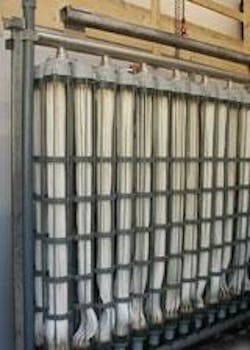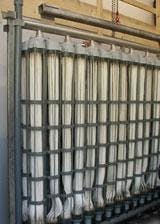Membrane Bioreactor System Streamlines Treatment
The MemJet™ membrane bioreactor (MBR) system from USFilter Jet Tech Products is a wastewater treatment process that combines a single sludge aerobic biological process with an integrated, immersed membrane system. This separation solution is ideally suited for a wide range of wastewater applications including water reuse, new housing developments, parks and resorts, retrofits and turnkey projects.
There are many equipment variations, configurations and options that can be used with the MBR system, all of which are designed to provide the necessary treatment for each wastewater project. Equipment selection is dependent on effluent requirements, maintenance and operation requirements, power consumption, future expansion and initial capital costs.
A few key features include:
• Submerged, low-pressure membranes consisting of polymeric hollow fibers that provide a physical barrier to remove suspended solids, including organics and microorganisms.
• A fluid renewal system that uses mixed liquor distribution and recirculation jets (patent pending) to evenly distribute mixed liquor solids, liquid, and air to each membrane unit, eliminating potential polarization of suspended solids around the membrane fibers.
• A flexible process design to accommodate varying design requirements such as denitrification and phosphorous removal.
• A membrane monitoring system to continuously monitor and record such important operational parameters as transmembrane pressure, flow, temperature, membrane resistance and turbidity.
The biological process and membrane operating system are located in separate tanks to allow the former to incorporate nearly any necessary biological process and the latter to provide high-quality effluent.
This form of filtration also eliminates the need for clarifiers, return sludge pumping, polishing effluent filters and maintenance normally associated with a passive clarification process. Operation of the treatment process is easily automated and can be controlled with a microprocessor.
Eliminating clarifiers allows the biological process to be designed and operated for wastewater treatment, not sludge settleability. It also allows the biological system to be operated at much higher mixed liquor suspended solids (MLSS) concentrations (8,000 to 16,000 mg/L). This creates a more efficient biological process that increases solids retention time, reduces sludge yield and improves reactor efficiency for nitrification and denitrification.
High MLSS levels also mean that plants can operate at shorter hydraulic retention times, allowing smaller reactor basins than conventional treatment and reducing plant space requirements. This often allows an existing conventional plant to be retrofitted with a membrane system, producing greater wastewater volumes in the same plant space, as well as higher quality water.

